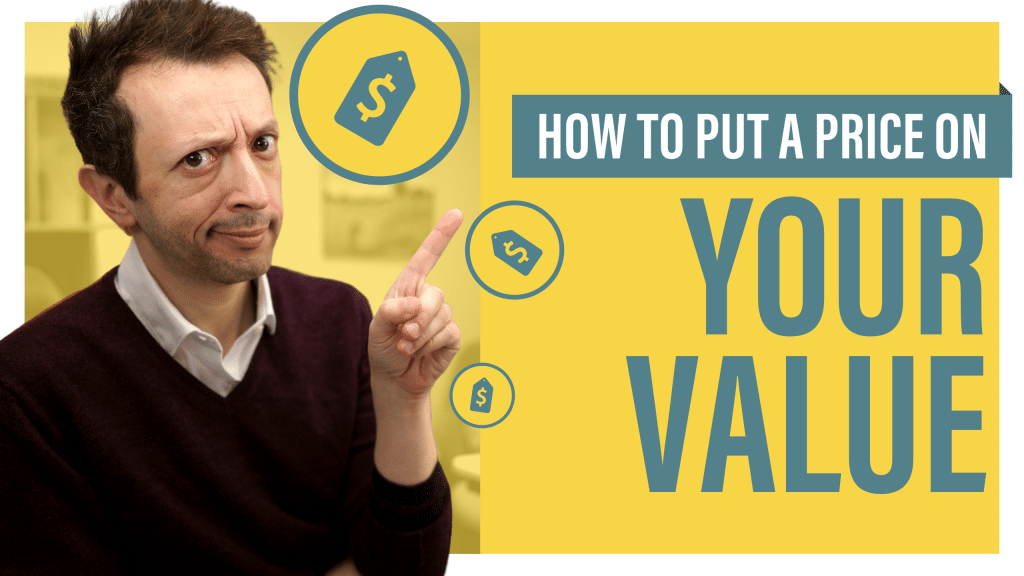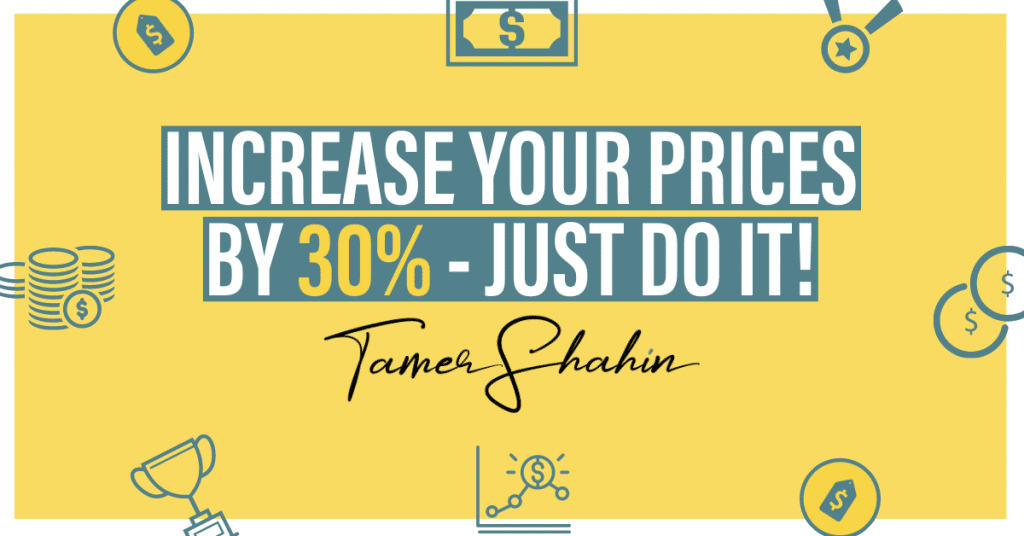
Are you charging your worth?
I don’t know about you, but when I first set out to start a business, I was so excited that I thought absolutely nothing could bring me down… and then it happened.
People started to ask me the BIG question in business – How much do you charge?
Ugh, it’s awful, isn’t it? It sends shivers up your spine, your palms get clammy, and before you know it, you’re stuttering out prices that do not reflect your true worth. If you do this, stop it!
One of the great mysteries in running a business is why we all get so petrified whenever we have to put a price on our value. We’re running a business to make money. So, why do we find it so excruciatingly difficult to charge our worth?
I’ll tell you why in this post and I’ll also tell you why you need to start charging your worth and put a price on your value so that you can finally start scaling your business (Spoiler – you’re worth a whole lot more than you think!).
Hit play on the video below or read on for more…
Why are you worried about asking for money?
This is an important question to ask yourself because no matter what way you try to look at it, you are running a business to make money. Sure, you’re selling unique products or providing services and giving your customers real value, but why are you selling those things?
To make money! So, why does asking for money seem like such a terrible thing to do?
I’ll tell you why. I blame society (no surprises there). Think about it though. From a very young age, we learn that money is the ‘root of all evil.’ Therefore, wanting money and (even worse) asking for money, means that others are going to perceive you as evil too.
But this isn’t true at all. Money is not evil. Just because you want your business to make money, doesn’t make you a greedy, money hungry criminal. It makes you an entrepreneur.
Money can be used to make a positive change. Speaking of change, you need to change the way you think about money. You need to make money so that you can achieve the freedom you want.
How much should you ask for?
If you can already feel your heart racing, take a few deep breaths because this is an important conversation to have with yourself.
A lot of people stumble here and it’s not that surprising given what we just discussed (you know, the link between money and everything that’s wrong with the world?). However, many people under-price themselves.
If you think that you’re one of those people, here’s what I want you to do…
INCREASE YOUR PRICES!
You don’t have to go over the top here but I do suggest that you increase your prices by 30%. Look, don’t overthink it. You are worth that extra 30% if not more. If it doesn’t work out, you can always adjust your pricing at a later date. But seriously, you have nothing to worry about. This works nine out of 10 times, so it’s worth a shot.
Your clients will gladly pay your new asking price IF you provide the value and the results they need.

Stop charging by the hour
Please tell me you’re not charging by the hour? (Seriously, don’t tell me).
Charging by the hour is not the best thing you can do to grow a scalable business. You didn’t go through all of this trouble and quit your day job to start your own business just so you could clock in and out, did you?
Trading your time for money is not going to help you to become a CEO entrepreneur.
The bottom line is that the product or service you’re selling delivers value and results. So, don’t charge by the hour. Your time is worth more than that.
How to figure out your pricing
When you’re trying to work out how much you should charge, ask yourself this question:
What do they stand to lose if I do not provide this value, product or service?
Slap a monetary value on that potential loss! Then, when you are selling your product or service, you can take the perspective of the potential customer or client. For example, if they don’t use your product or service, they stand to lose $ (enter amount of choice here).
Taking this perspective helps you (and your client) see the true value of paying for your services or product. They stand to lose even more money by not paying for the value that you’ll provide them.
The next step is to identify the outcome of the results and the solution you’re providing them. Considering all of this, you then need to identify what is that value and result worth? What do they stand to gain?
The gap between what they stand to lose and what they stand to gain is where your value proposition lies. You can pitch your little flag anywhere along this imaginary line – just don’t pitch it too low!
Remember to paint the vision for your clients. Make them understand just how valuable you are. For example, let’s say you charge $20k per month. Most people will see that number and run for the hills. Or, they’ll ask you for an intricate breakdown of everything you’ll be doing for them within that time-frame to try and justify the price.
How should you respond?
You respond by showing them the value you will be providing. Sure, you charge $20k a month and that’s a big price for many people. But the results you provide will make them $500k by the end of the year (for example).
Suddenly, the $20k investment in your product or service isn’t looking too shabby. When you put it like that, it looks like a very good deal!
How to identify your unique value proposition
You must position yourself as a business. This is where psychology and pricing strategy intertwine and you’ve got to pay attention to both.
To position yourself effectively, you must consider your brand. Are you a brand that competes on price? You know… your arch-nemesis in the business world drops their prices, so you drop yours, and the cycle continues until your prices reach an all-time low. It’s definitely not a good place to be and if you continue to compete on prices, you will never scale in the way you want to.
To get away from that, position yourself properly. This means identifying your unique value proposition. Need help with this? Sure thing.
Here are a few questions to help you out:
- What makes you unique?
- How will your value transfer?
Now that all of that is out of the way, let’s get into how you can actually position yourself in the market.
How to position yourself in the market
The last thing you want is for people to look at your pricing, see that it’s low, and assume that there must be something wrong with it.
If you’re looking for a new pair of designer shoes or trainers from a popular sports brand and you happen to find the exact pair of shoes you’re looking for a tenth of the price, you’ll be tempted to perform a little celebratory dance right there in the store. OR, you’ll look at the shoes, glance at the super cheap price tag and think to yourself… it’s probably fake.
Why? Well, if something looks too good to be true, it probably is.
The same goes for your business. If you price yourself too low, people will assume it’s because what your offering isn’t worth very much at all.
Identify your target customer
When you’re looking at how you position yourself in the market, you need to make sure you know exactly who your target customer is. Not only that, but you need to develop a good understanding of who they are so that you can understand how much they can afford to pay to obtain the results you provide them with your product or service.
There’s no point targeting the wrong audience. If you target people who can’t afford you, you’ll have a hard time finding clients and scaling your business.
You must identify your target customer within your target market. Consider who needs your product or service and whether they are able to pay you the amount you want to charge.
Remember, don’t charge by the hour! You should charge for your experience. An hour of your time is worth more because of your experience and expertise.
Your price point should look at several factors:
- Your cost – you don’t want to be in a position where you’re losing money
- Your positioning
- What your target customer can afford to pay and what they stand to gain and lose
The human mind is an incredible thing. When we have an option to buy something that we really want and we’re given more than one choice (with each choice set at a different price point), our brain assumes that the higher the price, the more value you’ll receive from it.
Put a price on your value!
Working out your price doesn’t have to be difficult. First, you need to consider the cost. This is how much it costs you (not your client) to provide your product or service. Then, you need to think about the worth of your product or service. In other words, how much is it worth to your potential target market?
The worth is quantified in value. So, you can consider how much value you’re providing with your product or service. Identify what a potential customer stands to gain or lose if they don’t use your product or service. The gap between the two is where you’ll find your price.
If you’re struggling to price your value, keep this in mind:
Your price should always be much more than it’s costing you and be worth more to the customer than they’re paying.
Yes, getting your price point right can be difficult. But it will be so much easier if you take the time to work out how you will position your unique value proposition, communicate that to potential customers and so in a way that doesn’t mean you have to compete on price.
If you can break free from the chains of competing on price with competitors, you can accurately position yourself in the market. Once you’ve done this, you need to anchor your price according to the value that people get from your product or service. And, of course, you must ensure that your target customer segment can actually afford to pay you!
Here’s a final checklist to help you see how to put a price on your value:
- Make sure your customer can afford you
- Position yourself in a way that you’re perceived as high-value
- Ensure you provide a good value to cost ratio
- Make sure your price is a lot higher than the cost to you
I hope this has helped you to see that you shouldn’t be charging by the hour and you’re worth so much more than you think! Don’t forget that you can watch the video version of this, and my other blog posts, over on my YouTube channel.
If you missed my last video why not go and check it out – How to Succeed After Failing in Business – Part 2.




One Response
Great post on an important topic, CEOentrepreneur! Putting a price on your value can be a challenging task, but it’s critical for the success of any business. I appreciate the practical tips and insights you shared in this post.
Here are some actionable tips that I would add to help put a price on your value:
Conduct market research: Understanding what similar products or services are being sold for in the market will give you a good baseline for pricing your offerings. This will also help you understand your target audience and what they are willing to pay for your services.
Consider your costs: Make sure to factor in all your costs, including materials, labor, and overhead, when determining your prices. This will help you ensure that you are pricing your services at a level that will allow you to earn a profit.
Communicate your value proposition: Clearly communicate the unique value you bring to the table. Explain why your products or services are different and why they are worth the price you are asking. This will help you justify your prices to potential customers.
Test your prices: Don’t be afraid to experiment with different pricing strategies. Try offering discounts, bundles, or other incentives to see what resonates with your target audience. You can also survey your customers to get their feedback on your pricing.
Be flexible: Be open to adjusting your prices if necessary. If you’re not attracting enough customers, consider lowering your prices, or if you’re feeling overworked, consider increasing your prices to ensure you’re able to maintain your quality of work.
Thanks for sharing your insights on how to put a price on your value, CEOentrepreneur. I hope these tips will be helpful for others looking to do the same!